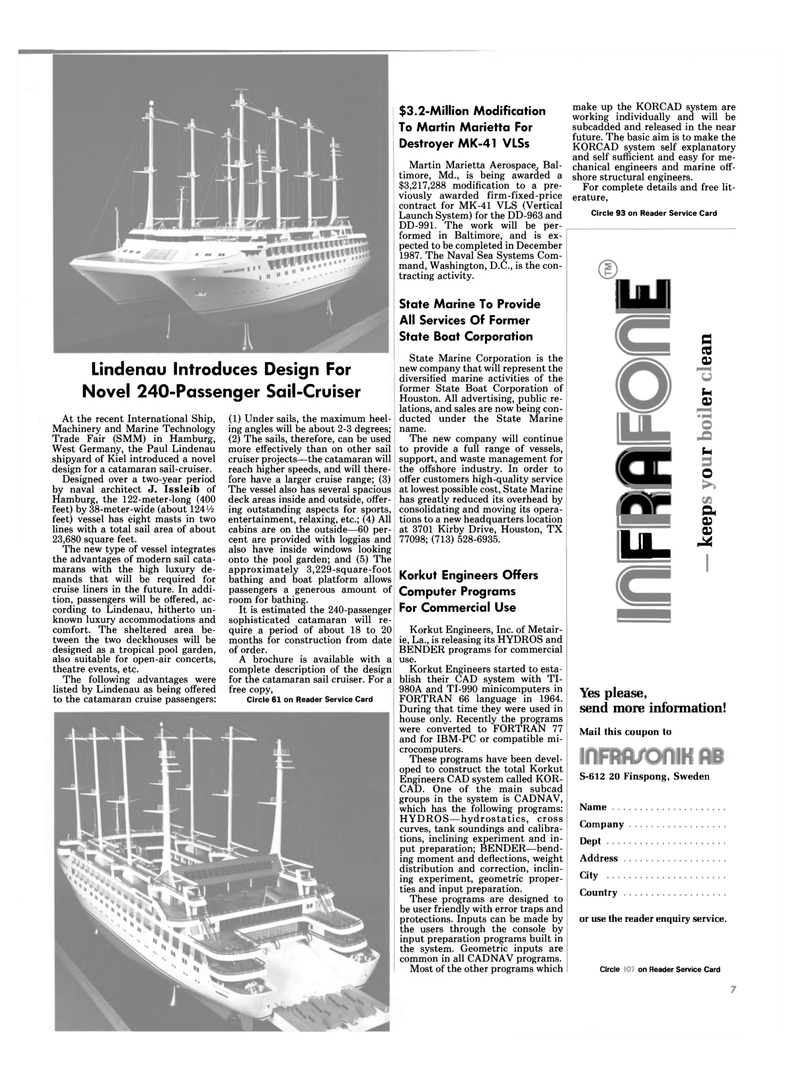
Page 5: of Maritime Reporter Magazine (November 1986)
Read this page in Pdf, Flash or Html5 edition of November 1986 Maritime Reporter Magazine
Lindenau Introduces Design For
Novel 240-Passenger Sail-Cruiser
At the recent International Ship,
Machinery and Marine Technology
Trade Fair (SMM) in Hamburg,
West Germany, the Paul Lindenau shipyard of Kiel introduced a novel design for a catamaran sail-cruiser.
Designed over a two-year period by naval architect J. Issleib of
Hamburg, the 122-meter-long (400 feet) by 38-meter-wide (about 124 V2 feet) vessel has eight masts in two lines with a total sail area of about 23,680 square feet.
The new type of vessel integrates the advantages of modern sail cata- marans with the high luxury de- mands that will be required for cruise liners in the future. In addi- tion, passengers will be offered, ac- cording to Lindenau, hitherto un- known luxury accommodations and comfort. The sheltered area be- tween the two deckhouses will be designed as a tropical pool garden, also suitable for open-air concerts, theatre events, etc.
The following advantages were listed by Lindenau as being offered to the catamaran cruise passengers: (1) Under sails, the maximum heel- ing angles will be about 2-3 degrees; (2) The sails, therefore, can be used more effectively than on other sail cruiser projects—the catamaran will reach higher speeds, and will there- fore have a larger cruise range; (3)
The vessel also has several spacious deck areas inside and outside, offer- ing outstanding aspects for sports, entertainment, relaxing, etc.; (4) All cabins are on the outside—60 per- cent are provided with loggias and also have inside windows looking onto the pool garden; and (5) The approximately 3,229-square-foot bathing and boat platform allows passengers a generous amount of room for bathing.
It is estimated the 240-passenger sophisticated catamaran will re- quire a period of about 18 to 20 months for construction from date of order.
A brochure is available with a complete description of the design for the catamaran sail cruiser. For a free copy,
Circle 61 on Reader Service Card $3.2-Million Modification
To Martin Marietta For
Destroyer MK-41 VLSs
Martin Marietta Aerospace, Bal- timore, Md., is being awarded a $3,217,288 modification to a pre- viously awarded firm-fixed-price contract for MK-41 VLS (Vertical
Launch System) for the DD-963 and
DD-991. The work will be per- formed in Baltimore, and is ex- pected to be completed in December 1987. The Naval Sea Systems Com- mand, Washington, D.C., is the con- tracting activity.
State Marine To Provide
All Services Of Former
State Boat Corporation
State Marine Corporation is the new company that will represent the diversified marine activities of the former State Boat Corporation of
Houston. All advertising, public re- lations, and sales are now being con- ducted under the State Marine name.
The new company will continue to provide a full range of vessels, support, and waste management for the offshore industry. In order to offer customers high-quality service at lowest possible cost, State Marine has greatly reduced its overhead by consolidating and moving its opera- tions to a new headquarters location at 3701 Kirby Drive, Houston, TX 77098;(713) 528-6935.
Korkut Engineers Offers
Computer Programs
For Commercial Use
Korkut Engineers, Inc. of Metair- ie, La., is releasing its HYDROS and
BENDER programs for commercial use.
Korkut Engineers started to esta- blish their CAD system with TI- 980A and TI-990 minicomputers in
FORTRAN 66 language in 1964.
During that time they were used in house only. Recently the programs were converted to FORTRAN 77 and for IBM-PC or compatible mi- crocomputers.
These programs have been devel- oped to construct the total Korkut
Engineers CAD system called KOR-
CAD. One of the main subcad groups in the system is CADNAV, which has the following programs:
HYDROS—hydrostatics, cross curves, tank soundings and calibra- tions, inclining experiment and in- put preparation; BENDER—bend- ing moment and deflections, weight distribution and correction, inclin- ing experiment, geometric proper- ties and input preparation.
These programs are designed to be user friendly with error traps and protections. Inputs can be made by the users through the console by input preparation programs built in the system. Geometric inputs are common in all CADNAV programs.
Most of the other programs which make up the KORCAD system are working individually and will be subcadded and released in the near future. The basic aim is to make the
KORCAD system self explanatory and self sufficient and easy for me- chanical engineers and marine off- shore structural engineers.
For complete details and free lit- erature,
Circle 93 on Reader Service Card u m hPir
U- fi cd aJ
Jh 03
Sh o ft 03 03
M
Yes please, send more information!
Mail this coupon to
S-612 20 Finspong, Sweden
Name
Company
Dept
Address
City
Country or use the reader enquiry service.
Circle 333 on Reader Service Card •>

 4
4

 6
6
